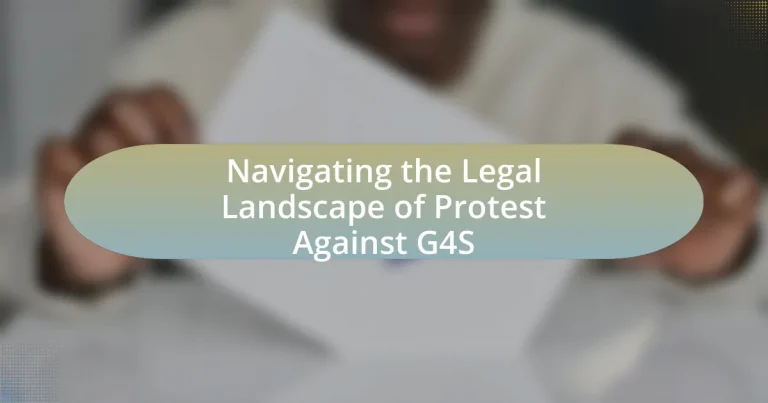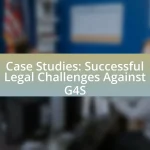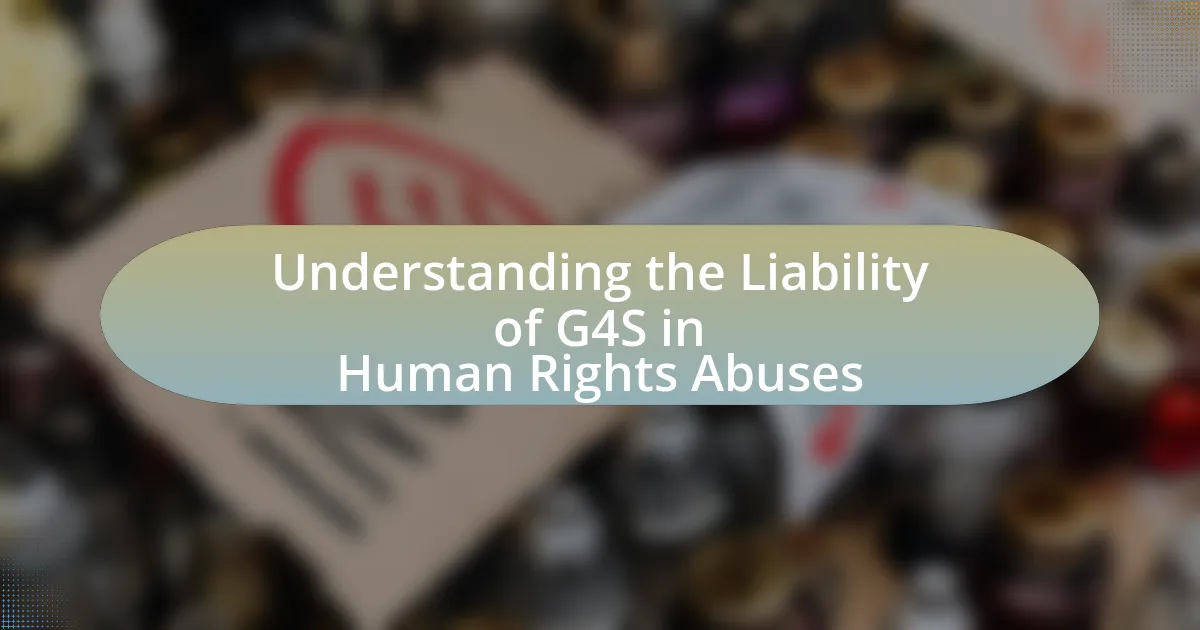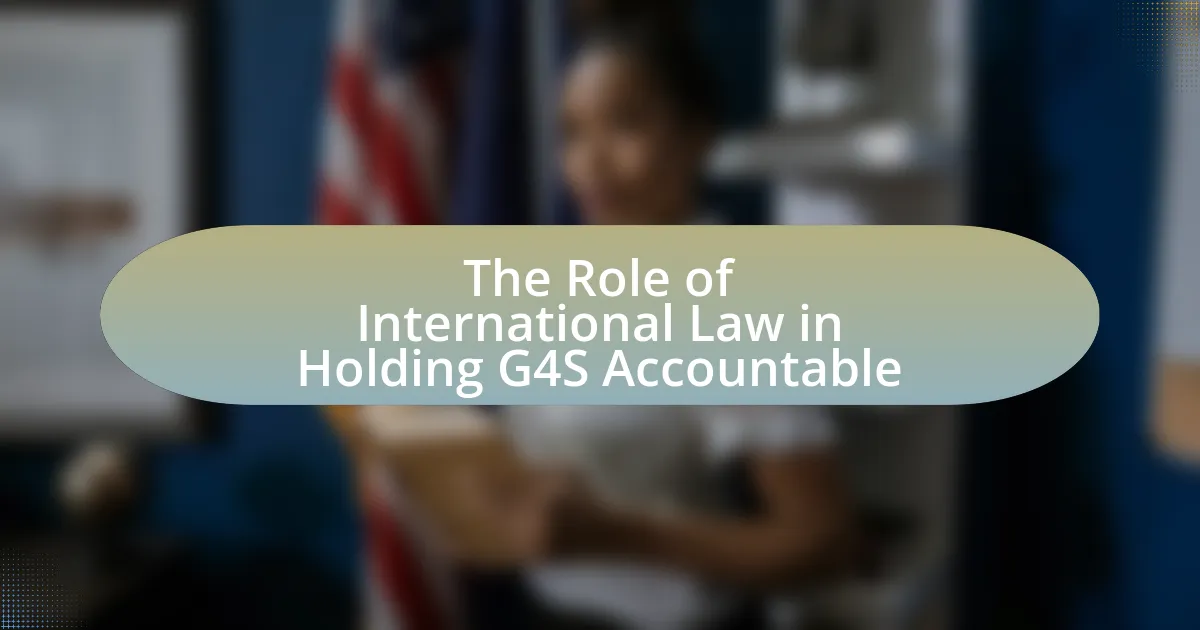The article focuses on the legal landscape surrounding protests against G4S, a private security firm, examining the laws that govern public assembly and freedom of expression. It outlines how regulations, such as the Public Order Act 1986 in the UK and the First Amendment in the U.S., impact the rights of protesters and the strategies they employ. The article also discusses the legal challenges faced by activists, the rights they possess under national and international law, and the potential legal repercussions of protesting against G4S. Additionally, it highlights best practices for organizing compliant protests and the importance of understanding local regulations to minimize legal risks.
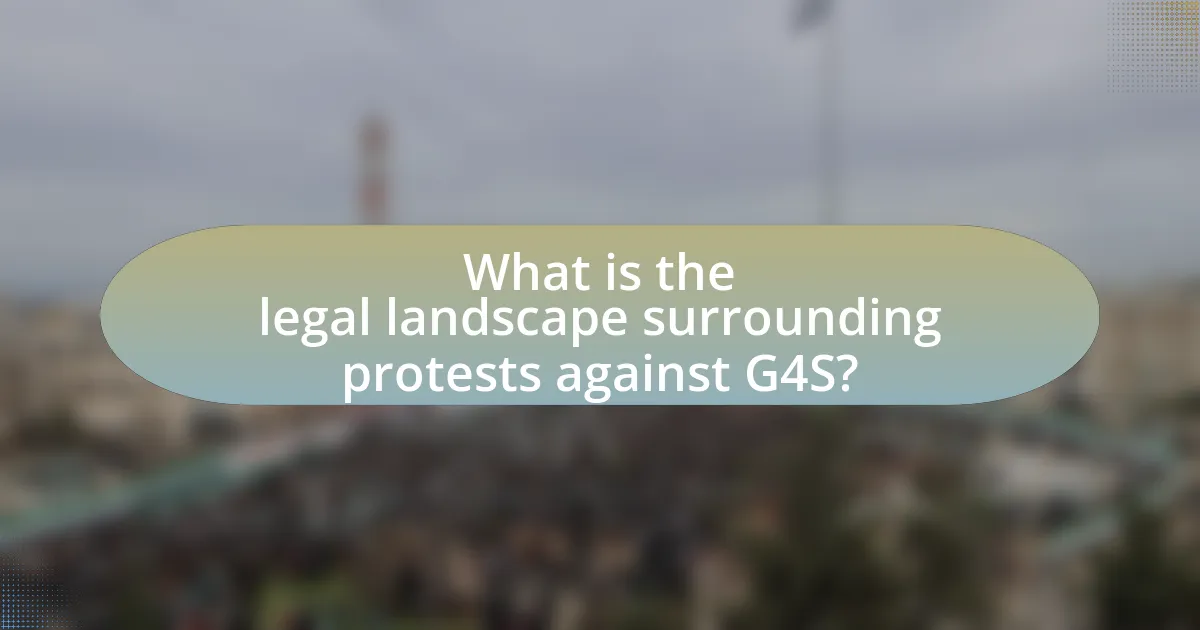
What is the legal landscape surrounding protests against G4S?
The legal landscape surrounding protests against G4S is shaped by laws governing public assembly, freedom of expression, and specific regulations related to private security firms. In many jurisdictions, individuals have the right to protest peacefully, which is protected under laws such as the First Amendment in the United States or similar provisions in other countries. However, these rights can be limited by local ordinances that regulate the time, place, and manner of protests.
For instance, in the UK, the Public Order Act 1986 provides police with powers to impose conditions on protests to prevent disorder, while also ensuring that the right to protest is upheld. Additionally, G4S, as a private security company, may seek injunctions or employ legal measures to limit protests on its property or against its operations, citing trespass or disruption to business.
Legal precedents, such as cases involving the balance between public order and the right to protest, further define this landscape. Courts often weigh the rights of protesters against the interests of businesses and public safety, leading to varied outcomes based on specific circumstances.
How do laws and regulations impact protests against G4S?
Laws and regulations significantly impact protests against G4S by establishing the legal framework within which such demonstrations can occur. For instance, laws governing public assembly dictate the necessary permits, locations, and times for protests, which can either facilitate or hinder activists’ efforts. In the UK, the Public Order Act 1986 allows authorities to impose restrictions on protests deemed to cause disruption, directly affecting the strategies employed by protestors against G4S. Additionally, regulations regarding trespassing and property rights can lead to legal repercussions for demonstrators, influencing their choice of protest tactics. These legal constraints shape the overall effectiveness and visibility of protests against G4S, as activists must navigate these laws to avoid penalties while attempting to raise awareness about their causes.
What specific laws govern public protests in various jurisdictions?
Public protests are governed by a variety of laws that differ across jurisdictions, including constitutional rights, local ordinances, and specific statutes. In the United States, the First Amendment protects the right to free speech and assembly, allowing individuals to protest peacefully. However, states and municipalities may impose regulations such as requiring permits, designating specific protest areas, and establishing time restrictions. For example, California’s Penal Code Section 409.5 allows law enforcement to disperse unlawful assemblies, while New York City’s Administrative Code mandates permits for gatherings over a certain size. In the United Kingdom, the Public Order Act 1986 regulates protests, requiring prior notification for marches and allowing police to impose conditions. These laws reflect a balance between the right to protest and the need for public order, demonstrating the legal complexities involved in public demonstrations.
How do these laws differ in relation to G4S’s operations?
The laws governing protests differ significantly in relation to G4S’s operations, particularly in terms of public safety regulations and private security protocols. For instance, laws that protect the right to protest may impose restrictions on the locations and times of demonstrations, which G4S must navigate to ensure compliance while maintaining security at their facilities. Additionally, legislation regarding the use of force by private security personnel can vary, impacting how G4S manages protests. In the UK, the Private Security Industry Act 2001 regulates the conduct of security personnel, requiring G4S to train staff in de-escalation techniques to adhere to legal standards. These differences necessitate that G4S continually adapt its operational strategies to align with evolving legal frameworks surrounding protests.
What are the rights of protesters when opposing G4S?
Protesters opposing G4S have the right to assemble peacefully, express their views, and engage in free speech under the First Amendment of the U.S. Constitution. This legal framework protects their ability to organize demonstrations and voice dissent against G4S’s practices. Additionally, protesters are entitled to protection from unlawful arrest or excessive force by law enforcement, as established by various court rulings that affirm the right to protest as a fundamental democratic principle. These rights are further supported by international human rights standards, such as the Universal Declaration of Human Rights, which recognizes the right to peaceful assembly and freedom of expression.
What legal protections do protesters have under national law?
Protesters have legal protections under national law that typically include the right to free speech, assembly, and the ability to petition the government. These rights are often enshrined in constitutional provisions, such as the First Amendment in the United States, which guarantees freedom of expression and peaceful assembly. Additionally, many countries have specific laws that protect protesters from excessive force by law enforcement and ensure their right to gather in public spaces. For instance, the European Convention on Human Rights Article 11 protects the right to freedom of assembly and association, reinforcing that individuals can organize and participate in protests without fear of arbitrary arrest or violence.
How do international human rights laws apply to protests against G4S?
International human rights laws protect the rights of individuals to peacefully assemble and express their opinions, which directly applies to protests against G4S. These laws, including the International Covenant on Civil and Political Rights (ICCPR), affirm the right to freedom of assembly and expression, allowing individuals to protest against companies like G4S that may be involved in human rights violations. For instance, Article 21 of the ICCPR explicitly states that the right to peaceful assembly shall be recognized, and this has been upheld in various UN resolutions and reports that emphasize the importance of protecting protestors’ rights. Therefore, protests against G4S are supported by international human rights frameworks that mandate the protection of individuals exercising their rights to free expression and assembly.
What challenges do protesters face when organizing against G4S?
Protesters face significant challenges when organizing against G4S, primarily due to legal restrictions and potential repercussions. These challenges include navigating complex laws regarding public assembly, which can vary by location and often require permits that may be difficult to obtain. Additionally, protesters may encounter police surveillance and increased law enforcement presence, which can intimidate participants and deter public support. Historical instances, such as the 2017 protests against G4S in the UK, demonstrate that activists often face arrests and legal action, further complicating their efforts to mobilize effectively.
What legal obstacles can hinder protest activities?
Legal obstacles that can hinder protest activities include laws regulating public assembly, restrictions on speech, and permits required for demonstrations. For instance, many jurisdictions require protesters to obtain permits, which can be denied based on factors such as location, time, or anticipated disruption. Additionally, laws against trespassing can limit where protests can occur, particularly on private property. Restrictions on speech, such as anti-protest laws or ordinances that prohibit certain types of expressions, can also impede protest activities. Historical examples include the enforcement of curfews or the designation of protest-free zones, which have been used to limit the effectiveness of demonstrations.
How can protesters navigate potential legal repercussions?
Protesters can navigate potential legal repercussions by understanding their rights, adhering to local laws, and seeking legal counsel. Knowledge of the First Amendment rights in the United States, which protects freedom of speech and assembly, is crucial for protesters to assert their rights effectively. Additionally, being aware of specific local ordinances regarding protests, such as permits and designated areas for demonstrations, helps in avoiding legal issues. Engaging with legal organizations that specialize in civil rights, such as the American Civil Liberties Union (ACLU), can provide valuable resources and support. Furthermore, documenting interactions with law enforcement and having legal representation on standby can mitigate risks during protests.

How can protesters effectively prepare for legal challenges against G4S?
Protesters can effectively prepare for legal challenges against G4S by documenting all activities, understanding their legal rights, and seeking legal counsel. Comprehensive documentation, including video recordings and written accounts of events, provides crucial evidence in case of legal disputes. Familiarity with local laws regarding protests, such as permits and restrictions, helps protesters navigate potential legal pitfalls. Additionally, consulting with legal experts who specialize in civil rights or protest law ensures that protesters are informed about their rights and the legal implications of their actions. This preparation is essential, as legal challenges can arise from actions taken during protests, and having a solid understanding of the legal landscape can significantly impact the outcome of any legal proceedings.
What strategies can be employed to ensure compliance with local laws?
To ensure compliance with local laws, organizations can implement a comprehensive legal compliance program that includes regular training, legal audits, and consultation with legal experts. Regular training ensures that all employees are aware of relevant laws and regulations, while legal audits help identify potential compliance gaps. Consulting with legal experts provides tailored advice specific to the organization’s operations and local legal requirements. These strategies are supported by the fact that organizations with structured compliance programs are less likely to face legal penalties, as evidenced by a study from the Ethics and Compliance Initiative, which found that effective compliance programs significantly reduce the risk of legal violations.
How can protesters research and understand local regulations?
Protesters can research and understand local regulations by accessing official government websites, reviewing municipal codes, and consulting legal resources specific to their area. Local government websites often provide detailed information on permits, noise ordinances, and public assembly laws, which are crucial for compliance during protests. Additionally, legal aid organizations and civil rights groups frequently publish guides and resources that outline the rights of protesters and relevant local laws. For example, the American Civil Liberties Union (ACLU) offers resources that help individuals understand their rights in various jurisdictions. Engaging with local community groups or attending city council meetings can also provide insights into current regulations and any proposed changes.
What role do legal advisors play in protest planning?
Legal advisors play a crucial role in protest planning by ensuring that the actions taken by organizers comply with local laws and regulations. They provide guidance on legal rights, help secure necessary permits, and advise on the potential legal implications of various protest strategies. For instance, legal advisors can inform organizers about the boundaries of free speech protections and the legal consequences of civil disobedience, which is essential for minimizing risks during protests. Their expertise helps to navigate complex legal frameworks, thereby enhancing the safety and effectiveness of the protest while protecting participants from legal repercussions.
What documentation is essential for protesters to carry?
Protesters should carry identification documents, such as a government-issued ID or driver’s license, to establish their identity during protests. This documentation is crucial for verifying personal information in case of arrest or legal inquiries. Additionally, carrying a copy of local laws regarding protests can help protesters understand their rights and responsibilities, reducing the risk of legal issues. Legal observers or support contacts’ phone numbers should also be kept on hand to ensure immediate assistance if needed.
What types of permits may be required for protests against G4S?
Protests against G4S may require various permits, including a public assembly permit, a street closure permit, and a sound permit. Local laws often mandate that organizers obtain a public assembly permit to legally gather in public spaces, while a street closure permit may be necessary if the protest obstructs traffic. Additionally, if amplified sound equipment is used, a sound permit is typically required to comply with noise ordinances. These requirements can vary by jurisdiction, so it is essential for organizers to consult local regulations to ensure compliance.
How can protesters document their activities to protect their rights?
Protesters can document their activities to protect their rights by using various methods such as video recording, photography, and written accounts. These documentation methods serve as evidence of the events that transpire during protests, which can be crucial in legal contexts. For instance, video recordings can capture interactions with law enforcement, providing a clear account of any potential rights violations. According to the American Civil Liberties Union (ACLU), documenting protests can help ensure accountability and protect individuals from unlawful actions by authorities. Additionally, maintaining a detailed written record of events, including dates, times, and descriptions of incidents, can further substantiate claims of rights infringements.

What are the potential legal outcomes of protesting against G4S?
Protesting against G4S can lead to various legal outcomes, including potential arrests, civil liability, or court injunctions. Legal consequences may arise if protesters violate laws related to public assembly, trespassing, or disorderly conduct, as seen in numerous cases where law enforcement intervened during protests. For instance, in the UK, the Police, Crime, Sentencing and Courts Act 2022 has increased police powers to impose conditions on protests, which can result in legal repercussions for non-compliance. Additionally, G4S may pursue civil actions for damages if protests disrupt their operations or lead to property damage, as established in previous legal disputes involving corporate entities and protest actions.
What legal actions can G4S take against protesters?
G4S can take several legal actions against protesters, including seeking injunctions to prevent further protests, filing lawsuits for damages caused by the protests, and reporting unlawful activities to law enforcement for potential criminal charges. Injunctions can be obtained if the protests disrupt business operations or violate local laws. Lawsuits may be pursued if protesters cause property damage or financial loss, as seen in cases where companies have successfully claimed compensation for disruptions. Additionally, if protesters engage in illegal activities, G4S can involve law enforcement to address those actions, which may lead to arrests or charges against individuals involved.
What are the common lawsuits filed by corporations against protestors?
Corporations commonly file lawsuits against protestors for trespassing, defamation, and interference with business operations. Trespassing claims arise when protestors unlawfully enter private property, while defamation suits may be initiated if protestors make false statements that harm the corporation’s reputation. Additionally, corporations may pursue claims of interference with business operations when protests disrupt their activities, leading to financial losses. These legal actions are often aimed at protecting corporate interests and maintaining operational integrity.
How can protesters defend themselves against such legal actions?
Protesters can defend themselves against legal actions by documenting their activities, understanding their rights, and seeking legal counsel. Proper documentation, including video evidence and witness statements, can provide crucial support in legal disputes. Familiarity with local laws regarding protests, such as the right to assemble and freedom of speech, empowers protesters to assert their rights effectively. Additionally, consulting with legal professionals who specialize in civil rights can help protesters navigate the complexities of legal challenges, ensuring they are adequately represented and informed about their options.
What are the implications of legal outcomes for future protests?
Legal outcomes significantly influence future protests by establishing precedents that can either empower or restrict demonstrators. For instance, rulings that uphold the right to protest can encourage more individuals to participate, knowing their rights are protected, as seen in cases like the 2011 Occupy Wall Street protests where courts affirmed the right to assemble. Conversely, legal decisions that impose strict penalties or limitations on protest activities can deter participation, as evidenced by laws enacted in various states following high-profile protests that criminalized certain forms of civil disobedience. These legal frameworks shape the strategies and tactics employed by activists, influencing the overall landscape of public dissent.
How can past legal cases influence new protests against G4S?
Past legal cases can significantly influence new protests against G4S by shaping public perception and informing protest strategies. For instance, previous rulings that found G4S liable for human rights violations can galvanize activists, providing a legal precedent that underscores the company’s controversial practices. Additionally, the outcomes of these cases can serve as a rallying point, motivating communities to mobilize against perceived injustices and encouraging them to utilize similar legal arguments in their protests. Historical examples, such as the 2013 case where G4S was criticized for its role in the detention of asylum seekers, highlight how legal findings can energize public dissent and lead to organized actions against the company.
What lessons can be learned from previous protests against G4S?
Previous protests against G4S highlight the importance of strategic organization and legal awareness in activism. Activists learned that understanding local laws and regulations governing protests can significantly impact the effectiveness and safety of their actions. For instance, during protests in the UK, demonstrators faced legal challenges due to insufficient knowledge of public assembly laws, which led to arrests and disruptions. Additionally, the necessity of building coalitions with other organizations was evident, as collective action often amplifies voices and increases visibility. Historical instances, such as the protests against G4S’s involvement in the Israeli-Palestinian conflict, demonstrated that clear messaging and targeted campaigns can mobilize public support and influence corporate accountability. These lessons underscore the need for thorough preparation and collaboration in future protests against G4S.
What best practices should protesters follow to minimize legal risks?
Protesters should adhere to several best practices to minimize legal risks, including knowing their rights, remaining peaceful, and documenting events. Understanding legal rights, such as the right to free speech and assembly, helps protesters navigate interactions with law enforcement effectively. Maintaining a peaceful demeanor reduces the likelihood of escalation and potential legal consequences. Additionally, documenting the protest through video or photographs can provide evidence of lawful behavior and counter any false claims made by authorities. These practices are supported by legal precedents that affirm the rights of individuals to protest peacefully without facing undue legal repercussions.
How can effective communication strategies reduce misunderstandings with law enforcement?
Effective communication strategies can significantly reduce misunderstandings with law enforcement by fostering clarity and mutual understanding. Clear verbal and non-verbal communication helps convey intentions and expectations, minimizing the potential for misinterpretation. For instance, using straightforward language and active listening techniques can ensure that both parties comprehend each other’s perspectives, which is crucial during high-stress situations like protests. Research indicates that effective communication can lead to a 30% reduction in conflict escalation during police encounters, as demonstrated in studies conducted by the Police Executive Research Forum. This evidence underscores the importance of employing structured communication methods to enhance interactions with law enforcement, ultimately leading to safer and more productive engagements.
What are the key takeaways for organizing a legally compliant protest against G4S?
To organize a legally compliant protest against G4S, ensure you obtain the necessary permits from local authorities, as failure to do so can result in legal repercussions. Additionally, familiarize yourself with local laws regarding public assembly, including restrictions on location, time, and noise levels. It is crucial to communicate your intentions clearly to participants and law enforcement to maintain order and safety. Furthermore, consider the potential for counter-protests and have a plan in place to address any conflicts peacefully. These steps are essential to uphold the right to protest while minimizing legal risks.
